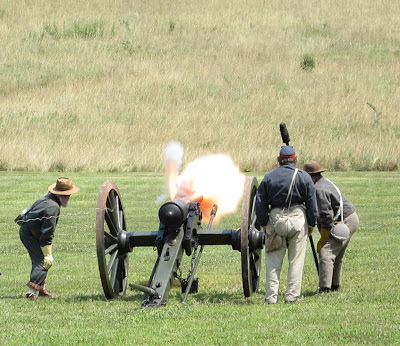
Photo by Mannie Gentile
Living history events are an excellent way to convey our interpretive messages and a major attraction for many park visitors. Do you remember attending a cooking demonstration or other living history program as a child or an adult? Historic weapons programs, farming demonstrations, or simply talking to a park employee in period dress can create a memorable experience. But how often do we look at the fire danger that can be associated with these events? Do the programs use open fires, either indoors or outdoors? Do they incorporate historic weapons or coal-fired engines? All of these activities can pose a high risk of fire danger.
Because many of these activities take place in historic structures, or new buildings that use period-specific building materials and techniques, they carry a higher fire risk. This is especially true given that fire inspection data show, that although not always required, many of our historic buildings do not have sprinkler protection and, if they do have sprinkler systems, they are often not adequately inspected, tested, maintained, or designed.
Living history events are great national park activities. Use the tips and tools in this issue of Prevention 52 to ensure that memories of the next living history event you attend or produce do not include a devastating fire.
Fire Info for You
Employees
If you are responsible for living history events, or buildings in which they are located, take the time to review your park's structural fire management plan to ensure that potential fire risks have been addressed. Understand the risks and ensure that prevention procedures are in place to keep you safe.
Park Leadership
Ensure that your park has a signed structural fire management plan in place and that all employees and volunteers have completed required annual fire extinguisher training and know their responsibilities during a fire event. If applicable, ensure that fire protection systems are inspected, tested, and maintained by a qualified person. Contact your regional structural fire manager for guidance and assistance.
Take Action
- Does your park offer living history programs or events? Take the time to investigate fire risks associated with these activities.
- Are open fires used, including candles or torches? Are combustible or flammable materials near open flames? Ensure that fire extinguishers are readily available, clearly marked, and inspected, and that employees know how to use them.
- When using historic weapons, remember the potential for fires, particularly when firing around open fields during hot and dry weather.
NPS Fire Facts
In 2005, a fire was burning in an open hearth during a living history event in historic Fort Clatsop, a replica of the fort built by Lewis and Clark near the mouth of the Columbia River. Embers from the fireplace escaped, igniting the wood structure. Lacking fire alarms or a fire suppression system, firefighter response was delayed and the historic fort was destroyed. Click here to learn more about Fort Clatsop.
Last updated: November 2, 2016
